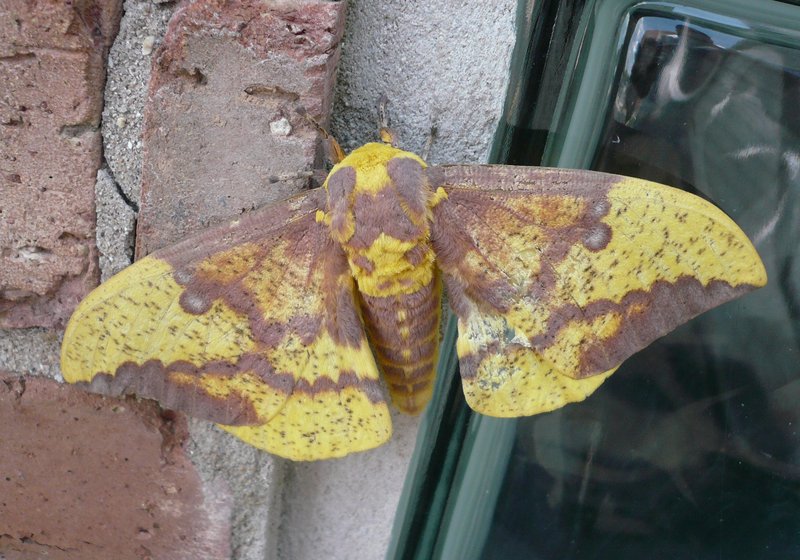Eacles imperialis
From Wikipedia, the free encyclopedia
[Photo] Eacles imperialis, adult male found in Palos Heights, Illinois. Date 2007-07-09. Author Joelmills http://commons.wikimedia.org/wiki/User:Joelmills
The Imperial Moth (Eacles imperialis) is a Nearctic member of the family Saturniidae and subfamily Ceratocampinae.
Range
It ranges from Mexico to Canada and from the Rocky Mountains to the Atlantic Coast.
Status
Eacles imperialis is one of a few saturniid species in a regional decline throughout the northeastern US, with some New England states lacking records for many decades. A colony on Martha's Vineyard, Massachussetts has been the subject of scientific and local political activity, especially concerning preservation of sensitive frost-bottom oak/pine habitat. Reasons for decline are unclear, as is the true northern limits of nominate imperialis' range, due to possible confusion with subspecies pini in existing records. Imperialis is certainly a common species of middle-atlantic states, appalachia, the Ohio Valley and Deep South regions, and is associated with forest, rural and suburban habitat. It is possible that to the north, imperialis requires specific habitat and the increasing fragmentation of niches such as coastal or montane pine barrens is a factor.
Life Cycle
There is only one brood a year.
Egg
Eggs are laid on the underside of leaves in clusters of 2-5. They take approximately two weeks to hatch. The day before they hatch, the egg turns from milky yellow to translucent white.
Larva
First instar lasts generally only a few days. After hatching, the caterpillars tend to wander around before finally settling on eating the particular plant they are on. After a few days, a small amount of silk is placed on the major vein of a leaf. The caterpillar then molts from that position leaving the old exoskeleton behind. Sometimes the shed exoskeleton is eaten. This continues on over most of the instar. Around the third or fourth instar, variation is noticeable. The caterpillars in the third and fourth instar vary from orange to black on the head, spines, body, and feet. In the fifth instar, there are two distinct variations in orange and green form.
Pupa
As with most of this subfamily, when the caterpillars are ready to pupate, they burrow underground.
Adult
Adults emerge once a year to mate. In the northern part of their range they tend to emerge mid summer (June - August), while in the southern half they tend to emerge at more varied times (April - October). A linked pair is vulnerable to predators, particularly foraging raccoons.
As with all of Saturniidae, the adults do not feed. Their mouthparts have been reduced.
Sexual Dimorphism
Sexual dimorphism is present in this species and all of Saturniidae :-
The males are generally smaller and show larger patches of purple.
The females are generally larger, mostly from carrying eggs, and are more yellow.
The antenna of the male is fibrous.
Food plants
Larvae feast on a variety of host plants including:
Quercus (Oak)
Acer (Maple)
Liquidambar styraciflua (American Sweetgum)
Sassafras albidum (Sassafras)
Pinus (Pine)
Other information
There is a high amount of variation within this species. The colors of the adult are always yellow and purple but can vary distinctly on this. Generally there is more purple on the forewing and more purple on males. However, one subspecies tends to have a distinct coating of purple over the entire wings.
Darker, heavily mottled individuals are typical forms of the southern and western range and may represent a clinal variation of nominate imperialis. Subspecies pini to the north, and sibling species Eacles oslari to the southwest exhibit similar morphs. Regional foodplant preferences have been noted as well, although captive-bred populations from all sources are nearly omnivorous.
http://en.wikipedia.org/wiki/Eacles_imperialis
| The text in this page is based on the copyrighted Wikipedia article shown in above URL. It is used under the GNU Free Documentation License. You may redistribute it, verbatim or modified, providing that you comply with the terms of the GFDL. |
|

